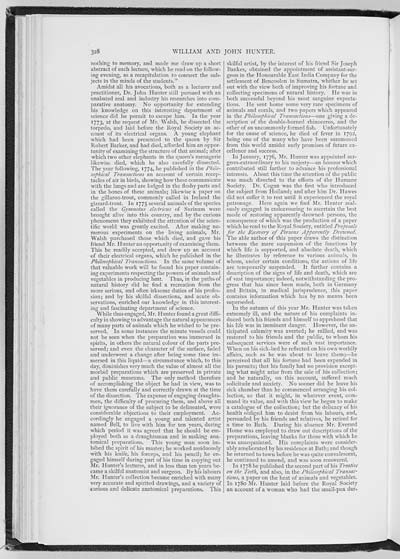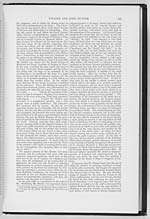328
nothing to memory, and made me draw up a short
abstract of each lecture, which he read on the follow-
ing evening, as a recapitulation to connect the sub-
jects in the minds of the students."
Amidst all his avocations, both as a lecturer and
practitioner, Dr. John Hunter still pursued with an
unabated zeal and industry his researches into com-
parative anatomy. No opportunity for extending
his knowledge on this interesting department of
science did he permit to escape him. In the year
1773, at the request of Mr. Walsh, he dissected the
torpedo, and laid before the Royal Society an ac-
count of its electrical organs. A young elephant
which had been presented to the queen by Sir
Robert Barker, and had died, afforded him an oppor-
tunity of examining the structure of that animal; after
which two other elephants in the queen's menagerie
likewise died, which he also carefully dissected.
The year following, 1774, he published in the Philo-
sophical Transactions an account of certain recep-
tacles of air in birds, showing how these communicate
with the lungs and are lodged in the fleshy parts and
in the bones of these animals; likewise a paper on
the gillaroo-trout, commonly called in Ireland the
gizzard-trout. In 1775 several animals of the species
called the Gymnotus electricus of Surinam were
brought alive into this country, and by the curious
phenomena they exhibited the attention of the scien-
tific world was greatly excited. After making nu-
merous experiments on the living animals, Mr.
Walsh purchased those which died, and gave his
friend Mr. Hunter an opportunity of examining them.
This he readily accepted, and drew up an account
of their electrical organs, which he published in the
Philosophical Transactions. In the same volume of
that valuable work will be found his paper contain-
ing experiments respecting the powers of animals and
vegetables in producing heat. Thus, in the paths of
natural history did he find a recreation from the
more serious, and often irksome duties of his profes-
sion; and by his skilful dissections, and acute ob-
servations, enriched our knowledge in this interest-
ing and fascinating department of science.
While thus engaged, Mr. Hunter found a great diffi-
culty in showing to advantage the natural appearances
of many parts of animals which he wished to be pre-
served. In some instances the minute vessels could
not be seen when the preparation was immersed in
spirits, in others the natural colour of the parts pre-
served; and even the character of the surface, faded
and underwent a change after being some time im-
mersed in this liquid�a circumstance which, to this
day, diminishes very much the value of almost all the
morbid preparations which are preserved in private
and public museums. The only method therefore
of accomplishing the object he had in view, was to
have them carefully and correctly drawn at the time
of the dissection. The expense of engaging draughts-
men, the difficulty of procuring them, and above all
their ignorance of the subject to be delineated, were
considerable objections to their employment. Ac-
cordingly he engaged a young and talented artist
named Bell, to live with him for ten years, during
which period it was agreed that he should be em-
ployed both as a draughtsman and in making ana-
tomical preparations. This young man soon im-
bibed the spirit of his master; he worked assiduously
with his knife, his forceps, and his pencil; he en-
gaged himself during part of his time in copying out
Mr. Hunter's lectures, and in less than ten years be-
came a skilful anatomist and surgeon. By his labours
Mr. Hunter's collection became enriched with many
very accurate and spirited drawings, and a variety of
curious and delicate anatomical preparations. This
skilful artist, by the interest of his friend Sir Joseph
Bankes, obtained the appointment of assistant-sur-
geon in the Honourable East India Company for the
settlement of Bencoolen in Sumatra, whither he set
out with the view both of improving his fortune and
collecting specimens of natural history. He was in
both successful beyond his most sanguine expecta-
tions. He sent home some very rare specimens of
animals and corals, and two papers which appeared
in the Philosophical Transactions�one giving a de-
scription of the double-horned rhinoceros, and the
other of an uncommonly formed fish. Unfortunately
for the cause of science, he died of fever in 1792,
being one of the many who have been summoned
from this world amidst early promises of future ex-
cellence and success.
In January, 1776, Mr. Hunter was appointed sur-
geon-extraordinary to his majesty�an honour which
contributed still farther to advance his professional
interests. About this time the attention of the public
was much directed to the efforts of the Humane
Society. Dr. Cogan was the first who introduced
the subject from Holland; and after him Dr. Hawes
did not suffer it to rest until it experienced the royal
patronage. Here again we find Mr. Hunter zeal-
ously engaged in endeavouring to ascertain the best
mode of restoring apparently drowned persons, the
consequence of which was the production of a paper
which he read to the Royal Society, entitled Proposals
for the Recovery of Persons Apparently Drowned.
The able author of this paper draws the distinction
between the mere suspension of the functions by
which life is supported, and absolute death, which
he illustrates by reference to various animals, in
whom, under certain conditions, the actions of life
are temporarily suspended. It further contains a
description of the signs of life and death, which are
of vast importance; indeed, notwithstanding the pro-
gress that has since been made, both in Germany
and Britain, in medical jurisprudence, this paper
contains information which has by no means been
superseded.
In the autumn of this year Mr. Hunter was taken
extremely ill, and the nature of his complaints in-
duced both his friends and himself to apprehend that
his life was in imminent danger. However, the an-
ticipated calamity was averted; he rallied, and was
restored to his friends and the public, to whom his
subsequent services were of such vast importance.
When on his sick-bed he reflected on his own worldly
affairs, such as he was about to leave them;�he
perceived that all his fortune had been expended in
his pursuits; that his family had no provision except-
ing what might arise from the sale of his collection;
and he naturally, on this account, suffered much
solicitude and anxiety. No sooner did he leave his
sick chamber than he commenced arranging his col-
lection, so that it might, in whatever event, com-
mand its value, and with this view he began to make
a catalogue of the collection; but the delicacy of his
health obliged him to desist from his labours, and,
persuaded by his friends and relatives, he retired for
a time to Bath. During his absence Mr. Everard
Home was employed to draw out descriptions of the
preparations, leaving blanks for those with which he
was unacquainted. His complaints were consider-
ably ameliorated by his residence at Bath; and though
he returned to town before he was quite convalescent,
he continued to amend, and was soon recovered.
In 1778 he published the second part of his Treatise
on the Teeth, and also, in the Philosophical Transac-
tions, a paper on the heat of animals and vegetables.
In 1780 Mr. Hunter laid before the Royal Society
an account of a woman who had the small-pox dur.

![]() Universal Viewer |
Universal Viewer | ![]() Mirador |
Large image | Transcription
Mirador |
Large image | Transcription
![]()

